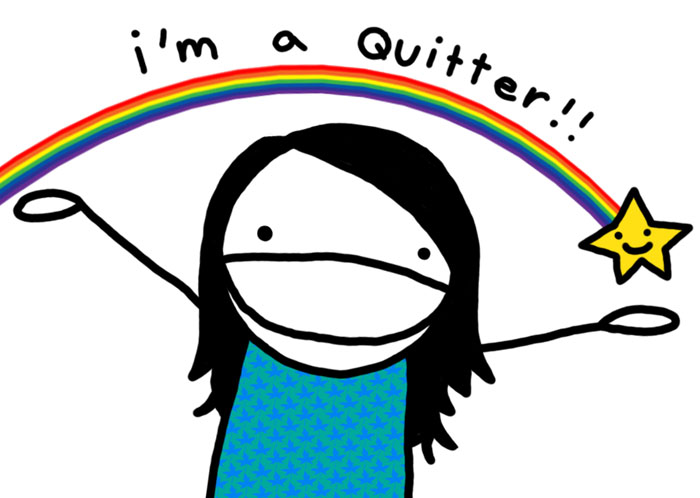If you (or your child) are considering giving up on playing an instrument, here’s a little checklist to see if it’s the right thing to do.
The Quitting Checklist:
1. Have you tried private lessons?
Individual attention helps, but it’s no magic pill. A student has to do at least some of what is prescribed to benefit from lessons. Sometimes it is actually the lesson experience that leads (generally younger) students to quit. When you just hate something, the last thing you need is accountability for excellence at it.
2. Have you been at it more than 6 months?
After the sexy initial phase of playing an instrument has passed, the practice has either become part of the culture of your life or it remains a chore. Careful, now: this is something of a Catch-22. If you haven’t gotten into a rhythm of playing almost every day, you haven’t seen the beauty of progress over time. You absolutely have to muscle yourself into this kind of pattern, but once you’ve seen how intensive work on the F scale a few weeks ago leads to a successful run through of a B-flat riddled section today, it gets easier to sit down and slog away.
3. Have you taken a break?
If you’ve done 1 and 2, then do this. Take your instrument and give it to someone for a week. Have it out of the house. Tell them not to let you have it until a full week has passed. If you have even a small desire to get it back before the week has elapsed, then you just needed a break to reevaluate your approach. Come back meaner, steadier, stronger.
If on the other hand, you feel like a burden has been lifted, pack it in an don’t look back. Donate it. Stick it in the attic for grandkids. Chuck it on Craigslist or take it to your luthier. The point of all of this is to have an enjoyable and productive life, so go forth and find what gives you joy.
If on the other, other hand that last statement gives you a pang of something you can’t quite get a handle on, get back to work. It’s something we all go through. The journey of an artist. You’ll know what’s right for you.
Happy quitter drawing by the incomparable Natalie Dee.



3 Responses
Thank you. I’ve been struggling with #3 for a couple years now…and I always end up back at it.
As someone who has taken forced breaks due to injury, recovery from surgery, and a degree, I get it. The frustration and heartbreak forges a deeper bond with the instrument and I think is essential to the identity of an artist.
Oh, and Gary Pratt at CSUN took my cello away from me when I told him I wanted to quit. 3 days in, I contemplated hiring a locksmith to break into his office to retrieve my captive darling. 🙂
I’m weird. I stopped lessons, but am still continuing on my own *cue ominous orchestra hit*. My teacher was and is fantastic, and I still stay in touch with him, but he was shoveling things at me too fast, and my work schedule was and will always be nuts. It’s really hard to transition to the one-inch-off-the-ground mentality you need to have as a beginner when you have been writing 30,000′-level proposals for your company for grant money the amounts of which are best written in scientific notation. 😛
Since stopping my lessons, I’ve continued to shed away on the viola at my own pace and am happily now at the point where my Suzuki v1 is approaching something I can be proud of as opposed to “well, you’re a beginner, of course it’s going to suck ass.” I wish I could do lessons where I could take four months of intensive lessons, and then go away and digest it by myself for six months.
Or where I could go through a Suzuki book three times before moving on. I don’t care about whether I can brag to some chuckleheads about who is in what book. I just want to be able to handle the device, and if that means I can play the stuff in book 1 better than a more “advanced” student can play their stuff in book 2, so be it. I tell myself that I’m like a bucket of cheap housepaint. Three coats gives full coverage. 🙂 Three passes through each Suzuki book, and I’m ready to move on.
I guess I’m just an autodidact at heart …